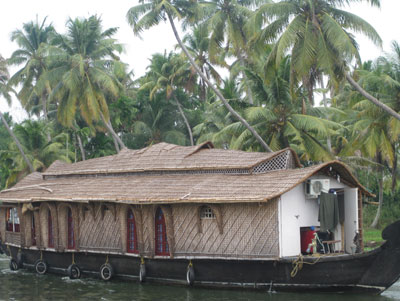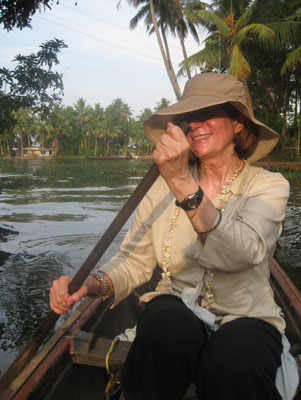Kerala backwater beauty
While in southern India in March ’09, my companion, Frank, and I traveled to the town of Alappuzha, formerly known as Alleppey. We had read about an exquisite estuary of interconnected canals, rivers, lakes and inlets where fresh water meets seawater from the Arabian Sea. Backwater tours originate from Alappuzha, three hours from Trivandrum, accessible by air and train.
We had planned an overnight on a kettuvallam, a floating cottage with a wooden hull and a thatched roof. We arranged this through our hotel about a hundred miles away in Kovalam, the Best Western Swagath Holiday Resort (phone 695 527 or visit http://resortsinkerala.com… or, in the US, call Best Western at 800/780-7234, www.best western.com), because we trusted the hotel and the desk clerk/manager. We had read that travelers should inspect the boat first, so we insisted on seeing the boat before we sailed.
At 11:30 in the morning, we were met on deck by our attentive crew with flower garlands and coconuts pierced with drinking straws. Frank and I, who were to be the only passengers, inspected the houseboat, which had a private, air-conditioned cabin with a locking door plus a Western toilet and shower.
Our boat took us down narrow canals, passing houses, breaking into a lake, then reaching an inland lagoon with storks, water lilies and lotuses, ringed by a shoreline with leaning palms, houses and Christian churches.
Women on shore pounded clothes against stone as they completed the daily wash. Children swam, men bathed and groups, including students with their backpacks, passed in canoes and water-buses.
Our first included meal was a satisfying lunch of rice and potatoes with cauliflower. Afterward, the crew tied the boat to a tree, allowing them to nap for an hour while we enjoyed the peace.
When we docked in late afternoon, a villager offered a canoe ride for 400 rupees (about $8), but we agreed on 300. This excursion allowed us to slip through inlets, visit a waterside Hindu temple, and wave to children fishing outside their front door.
At dinner we enjoyed coconut cabbage. Our young cook, who doubled as captain, proudly explained his mother’s recipe.
As darkness came, we listened to nature, only to become annoyed when tourists in another boat turned on a loud video that shined in our faces while echoing over the water.
After a good sleep, we awoke to a breakfast of omelettes, toast, fruit and tea. Upon our return to the dock, we tipped our crew $2 each, giving twice that amount to the captain/cook.
For the kettuvallam itself, including three freshly cooked meals and a crew of three, the price Frank and I had negotiated through the Best Western in Kovalam was about $50. Even better, the cost for the two of us to take a taxi 105 miles from Kovalam to Alappuzha plus the overnight boat plus having the taxi driver stay overnight in town to pick us up the next morning and drive us on to Ft. Kochi totaled under $75.
This is why it pays to work out things locally through one’s hotel. On the street, the local tour agencies wanted about $60 for the boat and more for the taxi.
From the backwater dock, our taxi driver took us north 3½ hours to Ft. Kochi. This seaport, which shares the Kerala backwater, bears the mark of Dutch, Portuguese and British colonial influence. We visited the St. Francis Church built by the Portuguese 500 years ago.
While walking in the city, we met a helpful tuk-tuk (3-wheeled cab) driver with whom we felt an instant rapport and arranged for a tour with him. The next day he took us around for almost three hours. Then, at our request, he left us at a restaurant for lunch, returning for us afterward.
After taking us to another place we asked to see, he delivered us back to our hotel. I think he probably asked for about $6, but we gave him about $10, generous tip included, because he was so patient, friendly and extraordinary.
Highlights of our tour included a 150-year-old banyan tree and a spice market. We watched the Chinese fishing nets weighted with stones and attended two performances at a cultural center. If we were to return to India, Ft. Kochi would be on our list.
Here are our Kerala travel tips.
• Study a backwater guide. Know where you want to go and for how many nights. Resort stays are available, depending on how deep into the backwaters you go. Some towns sponsor snake boat races; these are long, narrow canoes each with a raised brow and requiring dozens of oarsmen.
• Arrange your backwater tour through your hotel or someone you trust.
• See the boat first. Inspect for life jackets and fire extinguishers. Your sitting area should be open on three sides for the best view. A mosquito net is not needed in an air-conditioned cabin.
• For arrival and departure, prenegotiate a taxi rate, preferably through a hotel you trust.
• If you visit Ft. Kochi, stay in the central district for ease of sightseeing. Our hotel, Hotel Fort Queen (Manthra Road, Pandikkudy, Cochin 682 002, Kerala, India; phone +91 484 2210943, 44 or 45, fax +91 484 2226874, www.fortqueen.com), was a colonial-era building that wowed us with historical paintings, wood panels and spice and tea displays.
We stayed at the Fort Queen for $50 per night. Though not located in the central district, it was very adequate. However, it was a long walk (45-60 minutes) to Ft. Kochi’s central district, and the heat prevented me from wanting to make the hike. Still, the food was good, and the gracious, friendly clerk made me enjoy the hotel.
KIMBERLY EDWARDS
Sacramento, CA


